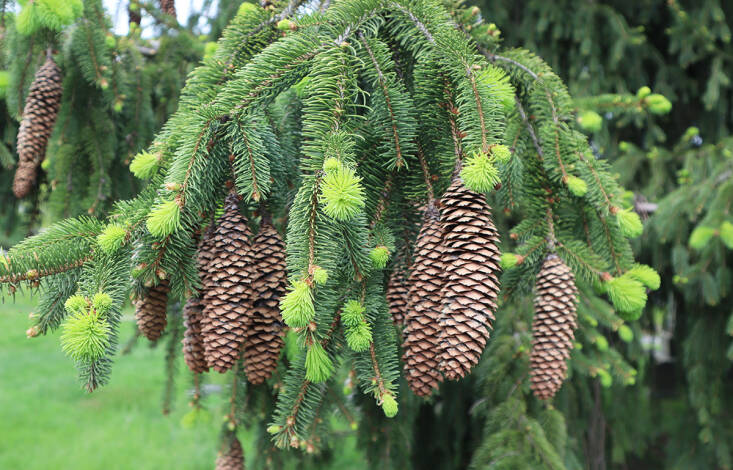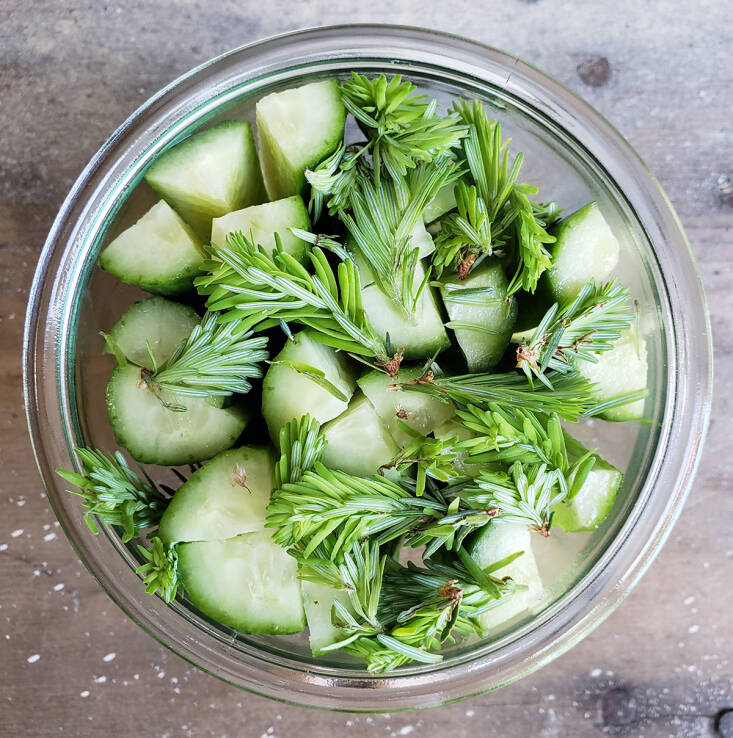Late spring coaxes tenderness from needled trees: This is the time to look up to find the soft tips of edible fir, spruce, and hemlock forming at the end of every branch on each of these aromatic evergreens. The tips are vividly, freshly green, and unmistakably distinct from the tough, mature needles of the previous year. They are a succulent addition to your seasonal culinary adventures.
Here’s how to use them.
Photography by Marie Viljoen.

But first: Did anyone recoil when they read “hemlock”? Just in case: The edible hemlock you may nibble for dinner in springtime is the common name of trees known botanically as Tsuga species, whereas the poisonous hemlock that conjures a skull-and-crossbones is a herbaceous plant, Conium maculatum. Physically, there is little chance of confusing the two.

Apart from being conifers, what fir, spruce, and hemlock also have in common is that their new growth in late spring is delicious. Their tender tips are sapid in a way unique to each tree, but they all have an element of citrus zest in their fragrance and flavor spectrum.

The softest new needles can be chewed up with pleasure, while the more developed tips lend themselves better to infusing and fermenting.

While edible conifer tips can be used interchangeably, here’s how to tell the difference between spruce, fir, and hemlock:
Spruce (Picea genus) and fir (Abies and Pseudotsuga) are the trees most easily confused with one another, because their short needles are attached individually to their branches (unlike pine needles, which grow in groups called packets).
Spruce needles are attached to tiny, woody projections. When the needles fall, spruce branches feel rough. Spruce needles are square in cross-section, and can be rolled between your fingers (I always murmur, “Spruce roll” to myself as I feel them). They are also very sharply pointed; grabbing a handful of mature spruce needles will hurt. Finally, looking at the tree as a whole, spruce cones point downwards.
- Spruce rough
- Spruce roll
- Spruce cones down
Fir needles, on the other hand, are flat, and cannot be rolled – they also feel softer. Fir branches don’t have projections to hold needles and their bark feels smoother. Fir cones point upwards.
- Fir smooth
- Fir flat
- Fir cones up

Hemlock (Tsuga) needles are arranged on a single plane, not spirally, like spruce and fir. So hemlock branches have a feathery and flatter appearance. Their fragrant needles are flat (they cannot roll), and their small cones are pendant.

If you are new to identifying needled trees, you may confuse hemlock with yew (Taxus). That would be bad: Yew is toxic. Yew does not have the pale stripes on the needles that hemlock and fir do, and, late in the year, its modified cones look like red, fleshy berries. For the rest of the year yew is cone-free, unlike other conifers. Hemlock is very fragrant when crushed, yew is not.

Now, let’s eat. And drink.

For spring-fresh quick pickles, add hemlock tips to sliced cucumbers, carrots, or celery in a jar, top with 50:50 seasoned white wine vinegar (just add salt and sugar to taste) and water, and leave to macerate for a minimum of one hour, or up to 24 hours, in the fridge.

Garnish soy-soaked eggs with tender spruce tips, whose texture, fragrance and slight citrus-peel vibe play well with the salty, creamy eggs. (To make soy eggs, boil large eggs for 8 minutes, peel, and place in a container – like a lunchbox – with enough soy sauce to reach halfway up their sides. Refrigerate for a minimum of 6 hours, turning the eggs halfway through.)

Fir tips have an affinity for salty and sweet. Toast your favorite bread/bagel/English muffin, top with a slab of feta, and place under a broiler until the cheese is soft (about 5 minutes). Crush the hot feta lightly with knife, then shower the soft, tangy fir needles across the top. Add a drizzle of honey and a flurry of fresh black pepper.

To make a scented salt, chop any edible conifer tips very finely and add the same volume of salt (I like to use flaky Maldon). Use fresh, or spread out to dry. It’s remarkably good as a seasoning for fire-grilled salmon or mushrooms…

As a simple garnish, spruce tips are a pretty choice for just about any drink. But you can also infuse gin, vodka, white rum, or silver Tequila with the fragrant tips. Just cover a cupful of the new needles with the liquor, leave to infuse for a minimum of 48 hours, strain, and bottle.

Fir and Rhubarb Cordial
Rhubarb arrives at local markets when edible conifer tips appear on trees. They are a delightful combination. This cordial is concentrated and requires dilution. Use 1 to 3 tablespoons topped with chilled sparkling water, shaken up in a drink, or drizzled over a warm sponge cake. Or cold ice cream!
- 1.5 lbs rhubarb, sliced
- 2 cups sugar
- 1 cup fir tips
Alternate layers of rhubarb and sugar in a large jar (6 – 8 cup capacity). Add enough water to cover the rhubarb. Close the lid and shake gently to dissolve the sugar. Loosen the lid, and leave out a room temperature for three days, shaking the mixture gently once a day (always loosen the lid, after). On Day 4 add the fir tips, pushing them down into the liquid. Leave out another 3 days. (By this time you may notice tiny bubbles rising if fermentation is active.) Strain the liquid through a fine mesh sieve and decant into a clean bottle. Keep it in the fridge. It lasts indefinitely.
For more of Marie’s recipes, see:
- 11 Favorites: Edible Flowers of Spring
- Chickweed: Taste the Stars
- Tree to Table: The Many Ways to Enjoy Magnolias










Have a Question or Comment About This Post?
Join the conversation (1)